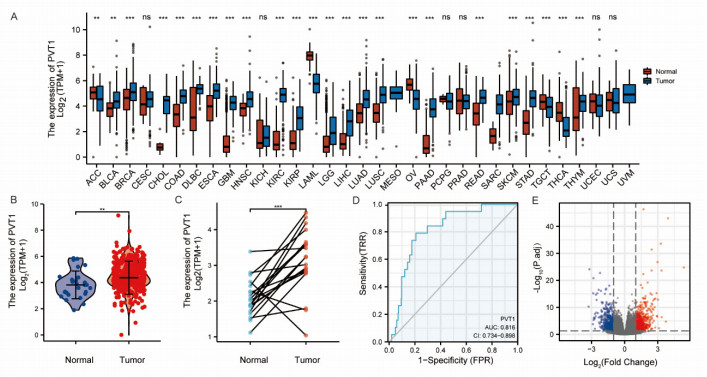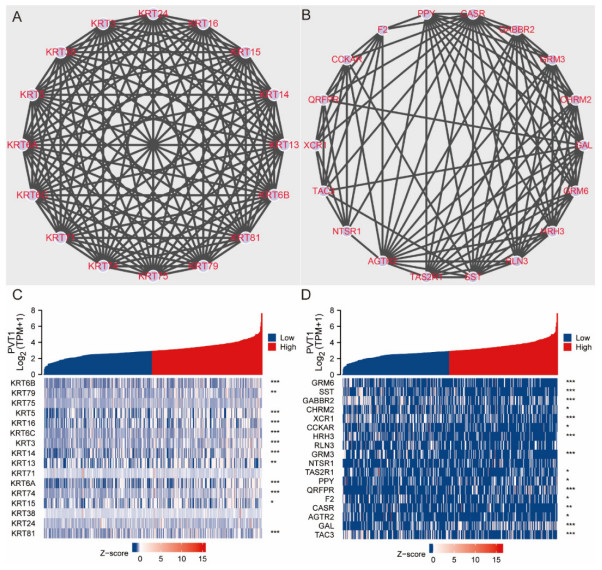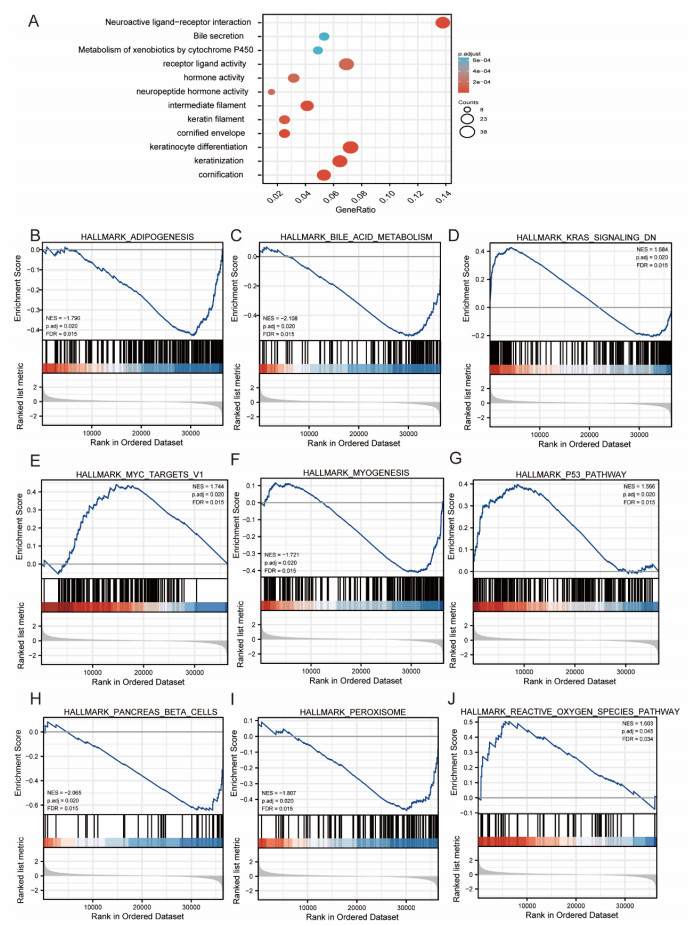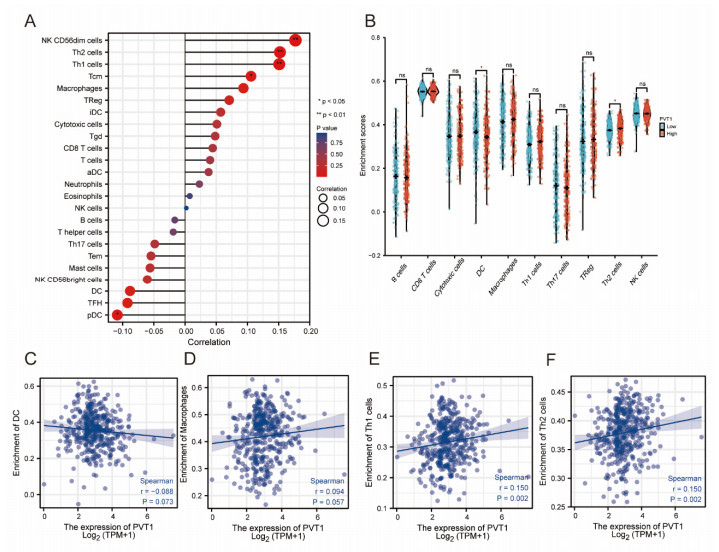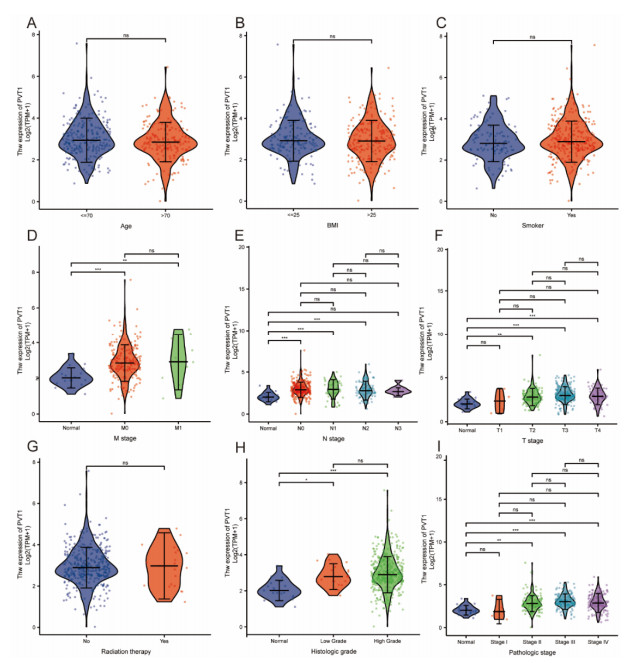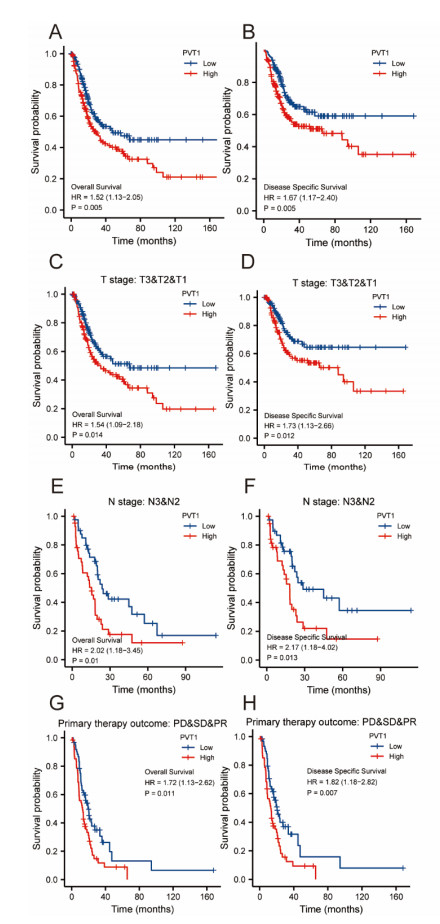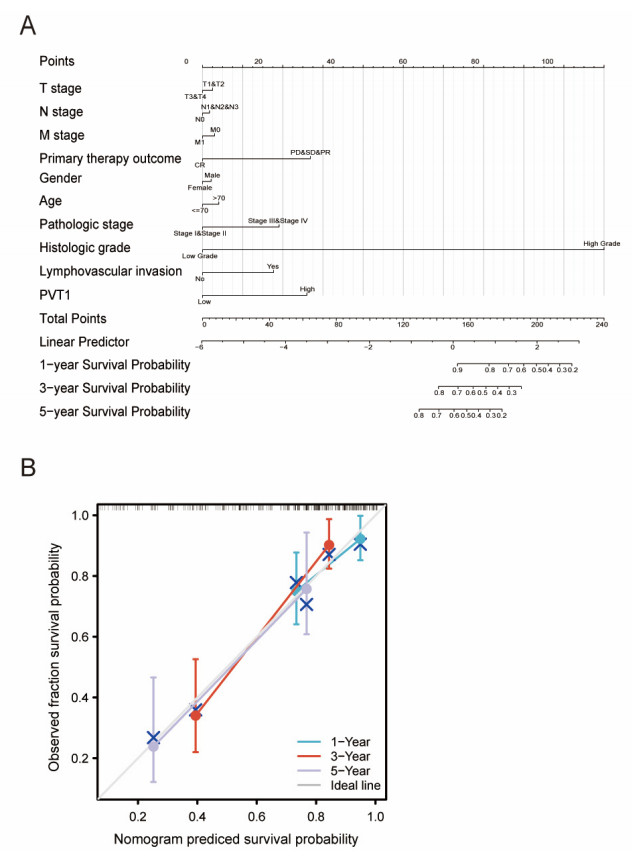|
[1]
|
L. A. Torre, F. Bray, R. L. Siegel, J. Ferlay, J. Lortet-Tieulent, A. Jemal, Global cancer statistics, 2012, CA Cancer J. Clin., 65 (2015), 87-108. doi: 10.3322/caac.21262.
|
|
[2]
|
W. J. Kim, S. C. Bae, Molecular biomarkers in urothelial bladder cancer, Cancer Sci., 99 (2008), 646-652. doi: 10.1111/j.1349-7006.2008.00735.x. doi: 10.1111/j.1349-7006.2008.00735.x

|
|
[3]
|
R. L. Siegel, K. D. Miller, A. Jemal, Cancer statistics, 2016, CA Cancer J. Clin., 66 (2016), 7-30. doi: 10.3322/caac.21332.
|
|
[4]
|
D. Tolomeo, A. Agostini, G. Visci, D. Traversa, C. T. Storlazzi, PVT1: A long non-coding RNA recurrently involved in neoplasia-associated fusion transcripts, Gene, 779 (2021), 145497. doi: 10.1016/j.gene.2021.145497.
|
|
[5]
|
Y. Y. Tseng, B. S. Moriarity, W. Gong, R. Akiyama, A. Tiwari, H. Kawakami, et al., PVT1 dependence in cancer with MYC copy-number increase, Nature, 512 (2014), 82-86. doi: 10.1038/nature13311.
|
|
[6]
|
Y. Kikuchi, S. Tokita, T. Hirama, V. Kochin, M. Nakatsugawa, T. Shinkawa, et al., CD8+ T-cell immune surveillance against a tumor antigen encoded by the oncogenic long non-coding RNA, PVT1, Cancer Immunol. Res., 9 (2021), 1342-1353. doi: 10.1158/2326-6066.CIR-20-0964.
|
|
[7]
|
E. Tesfaye, E. Martinez-Terroba, J. Bendor, L. Winkler, C. Olivero, K. Chen, et al., The p53 transcriptional response across tumor types reveals core and senescence-specific signatures modulated by long noncoding RNAs, Proc. Natl. Acad. Sci. USA, 118 (2021). doi: 10.1073/pnas.2025539118.
|
|
[8]
|
K. Shigeyasu, S. Toden, T. Ozawa, T. Matsuyama, T. Nagasaka, T. Ishikawa, et al., The PVT1 lncRNA is a novel epigenetic enhancer of MYC, and a promising risk-stratification biomarker in colorectal cancer, Mol. Cancer, 19 (2020), 155. doi: 10.1186/s12943-020-01277-4.
|
|
[9]
|
Z. Liu, H. Zhang, LncRNA plasmacytoma variant translocation 1 is an oncogene in bladder urothelial carcinoma, Mol. Cancer, 8 (2017), 64273-64282. doi: 10.18632/oncotarget.19604. doi: 10.18632/oncotarget.19604

|
|
[10]
|
Y. Wang, J. Zhou, Z. Wang, P. Wang, S. Li, Upregulation of SOX2 activated LncRNA PVT1 expression promotes breast cancer cell growth and invasion, Biochem. Bioph. Res. Commun., 493 (2017), 429-436. doi: 10.1016/j.bbrc.2017.09.005. doi: 10.1016/j.bbrc.2017.09.005

|
|
[11]
|
M. Iden, S. Fye, K. Li, T. Chowdhury, R. Ramchandran, J. S. Rader, The lncRNA PVT1 contributes to the cervical cancer phenotype and associates with poor patient prognosis, PLoS One, 11 (2016), e0156274. doi: 10.1371/journal.pone.0156274.
|
|
[12]
|
X. Yu, J. Zhao, Y. He, Long non-coding RNA PVT1 functions as an oncogene in human colon cancer through miR-30d-5p/RUNX2 axis, J BUON, 23 (2018), 48-54.
|
|
[13]
|
Y. R. Yang, S. Z. Zang, C. L. Zhong, Y. X. Li, S. S. Zhao, X. J. Feng, Increased expression of the lncRNA PVT1 promotes tumorigenesis in non-small cell lung cancer, Int. J. Clin. Exp. Pathol, 7 (2014), 6929-6935.
|
|
[14]
|
Y. Wu, W. Gu, X. Han, Z. Jin, LncRNA PVT1 promotes the progression of ovarian cancer by activating TGF-beta pathway via miR-148a-3p/AGO1 axis, J. Cell Mol. Med., (2021). doi: 10.1111/jcmm.16700.
|
|
[15]
|
J. Yang, C. Li, A. Mudd, X. Gu, LncRNA PVT1 predicts prognosis and regulates tumor growth in prostate cancer, Biosci. Biotech. Bioch., 81 (2017), 2301-2306. doi: 10.1080/09168451.2017.1387048. doi: 10.1080/09168451.2017.1387048

|
|
[16]
|
M. Izadifard, H. Pashaiefar, M. Yaghmaie, M. Montazeri, M. Sadraie, M. Momeny, et al., Expression analysis of PVT1, CCDC26, and CCAT1 long noncoding RNAs in acute myeloid leukemia patients, Genet. Test. Mol. Bioma., 22 (2018), 593-598. doi: 10.1089/gtmb.2018.0143.
|
|
[17]
|
A. Abbate, D. Tolomeo, I. Cifola, M. Severgnini, A. Turchiano, B. Augello, et al., MYC-containing amplicons in acute myeloid leukemia: genomic structures, evolution, and transcriptional consequences, Leukemia, 32 (2018), 2152-2166. doi: 10.1038/s41375-018-0033-0.
|
|
[18]
|
N. Yazdi, M. Houshmand, A. Atashi, A. Kazemi, A. A. Najmedini, M. N. Zarif, Long noncoding RNA PVT1: potential oncogene in the development of acute lymphoblastic leukemia, Turk. J. Biol., 42 (2018), 405-413. doi: 10.3906/biy-1801-46. doi: 10.3906/biy-1801-46

|
|
[19]
|
H. Handa, K. Honma, T. Oda, N. Kobayashi, Y. Kuroda, K. Kimura-Masuda, et al., Long Noncoding RNA PVT1 Is Regulated by Bromodomain Protein BRD4 in Multiple Myeloma and Is Associated with Disease Progression, Int. J. Mol. Sci., 21 (2020). doi: 10.3390/ijms21197121.
|
|
[20]
|
A. C. Panda, I. Grammatikakis, K. M. Kim, S. De, J. L. Martindale, R. Munk, et al., Identification of senescence-associated circular RNAs (SAC-RNAs) reveals senescence suppressor CircPVT1, Nucleic Acids Res., 45 (2017), 4021-4035. doi: 10.1093/nar/gkw1201.
|
|
[21]
|
L. Wan, M. Sun, G. J. Liu, C. C. Wei, E. B. Zhang, R. Kong, et al., Long noncoding RNA PVT1 promotes non-small cell lung cancer cell proliferation through epigenetically regulating lats2 expression, Mol. Cancer Ther., 15 (2016), 1082-1094. doi: 10.1158/1535-7163.MCT-15-0707.
|
|
[22]
|
C. Zeng, X. Yu, J. Lai, L. Yang, S. Chen, Y. Li, Overexpression of the long non-coding RNA PVT1 is correlated with leukemic cell proliferation in acute promyelocytic leukemia, J. Hematol. Oncol., 8 (2015), 126. doi: 10.1186/s13045-015-0223-4.
|
|
[23]
|
D. Guo, Y. Wang, K. Ren, X. Han, Knockdown of LncRNA PVT1 inhibits tumorigenesis in non-small-cell lung cancer by regulating miR-497 expression, Exp. Cell Res., 362 (2018), 172-179. doi: 10.1016/j.yexcr.2017.11.014. doi: 10.1016/j.yexcr.2017.11.014

|
|
[24]
|
G. Ping, W. Xiong, L. Zhang, Y. Li, Y. Zhang, Y. Zhao, Silencing long noncoding RNA PVT1 inhibits tumorigenesis and cisplatin resistance of colorectal cancer, Am. J. Transl. Res., 10 (2018), 138-149.
|
|
[25]
|
X. Z. Wu, H. P. Cui, H. J. Lv, L. Feng, Knockdown of lncRNA PVT1 inhibits retinoblastoma progression by sponging miR-488-3p, Biomed. Pharmacother., 112 (2019), 108627. doi: 10.1016/j.biopha.2019.108627.
|
|
[26]
|
Y. Cai, J. Wan, Competing endogenous RNA regulations in neurodegenerative disorders: current challenges and emerging insights, Front. Mol. Neurosci., 11 (2018), 370. doi: 10.3389/fnmol.2018.00370.
|
|
[27]
|
X. Qi, D. H. Zhang, N. Wu, J. H. Xiao, X. Wang, W. Ma, ceRNA in cancer: possible functions and clinical implications, J. Med. Genet., 52 (2015), 710-718. doi: 10.1136/jmedgenet-2015-103334. doi: 10.1136/jmedgenet-2015-103334

|
|
[28]
|
M. Chen, R. Zhang, L. Lu, J. Du, C. Chen, K. Ding, et al., LncRNA PVT1 accelerates malignant phenotypes of bladder cancer cells by modulating miR-194-5p/BCLAF1 axis as a ceRNA, Aging (Albany NY), 12 (2020), 22291-22312. doi: 10.18632/aging.202203.
|
|
[29]
|
C. Yu, L. Liu, W. Long, Z. Feng, J. Chen, L. Chao, et al., LncRNA PVT1 regulates VEGFC through inhibiting miR-128 in bladder cancer cells, J. Cell Physiol., 234 (2019), 1346-1353. doi: 10.1002/jcp.26929.
|
|
[30]
|
V. Karantza, Keratins in health and cancer: more than mere epithelial cell markers, Oncogene, 30 (2011), 127-138. doi: 10.1038/onc.2010.456. doi: 10.1038/onc.2010.456

|
|
[31]
|
P. A. Coulombe, M. B. O mary, 'Hard' and 'soft' principles defining the structure, function and regulation of keratin intermediate filaments, Curr. Opin. Cell Biol., 14 (2002), 110-122.
|
|
[32]
|
R. Moll, M. Divo, L. Langbein, The human keratins: biology and pathology, Histochem. Cell Biol., 129 (2008), 705-733. doi: 10.1007/s00418-008-0435-6. doi: 10.1007/s00418-008-0435-6

|
|
[33]
|
J. I. Epstein, An update of the Gleason grading system, J. Urol., 183 (2010), 433-440. doi: 10.1016/j.juro.2009.10.046. doi: 10.1016/j.juro.2009.10.046

|
|
[34]
|
S. Liu, R. M. Cadaneanu, B. Zhang, L. Huo, K. Lai, X. Li, et al., Keratin 13 Is Enriched in Prostate Tubule-Initiating Cells and May Identify Primary Prostate Tumors that Metastasize to the Bone, PLoS One, 11 (2016), e0163232. doi: 10.1371/journal.pone.0163232.
|
|
[35]
|
S. Bundela, A. Sharma, P. S. Bisen, Potential therapeutic targets for oral cancer: ADM, TP53, EGFR, LYN, CTLA4, SKIL, CTGF, CD70, PLoS One, 9 (2014), e102610. doi: 10.1371/journal.pone.0102610.
|
|
[36]
|
J. A. Sharp, S. L. Mailer, P. C. Thomson, C. Lefevre, K. R. Nicholas, Identification and transcript analysis of a novel wallaby (Macropus eugenii) basal-like breast cancer cell line, Mol. Cancer, 7 (2008), 1. doi: 10.1186/1476-4598-7-1.
|
|
[37]
|
L. Lima, M. Neves, M. I. Oliveira, L. Dieguez, R. Freitas, R. Azevedo, et al., Sialyl-Tn identifies muscle-invasive bladder cancer basal and luminal subtypes facing decreased survival, being expressed by circulating tumor cells and metastases, Urol. Oncol., 35 (2017), 675 e1-675 e8. doi: 10.1016/j.urolonc.2017.08.012.
|
|
[38]
|
M. Eckstein, R. M. Wirtz, M. Gross-Weege, J. Breyer, W. Otto, R. Stoehr, et al., mRNA-expression of KRT5 and KRT20 defines distinct prognostic subgroups of muscle-invasive urothelial bladder cancer correlating with histological variants, Int. J. Mol. Sci., 19 (2018). doi: 10.3390/ijms19113396.
|
|
[39]
|
S. W. Cho, J. Xu, R. Sun, M. R. Mumbach, A. C. Carter, Y. G. Chen, et al., Promoter of lncRNA Gene PVT1 Is a Tumor-Suppressor DNA Boundary Element, Cell, 173 (2018), 1398-1412. doi: 10.1016/j.cell.2018.03.068.
|
|
[40]
|
Y. Wang, C. E. Kaiser, B. Frett, H. Y. Li, Targeting mutant KRAS for anticancer therapeutics: a review of novel small molecule modulators, J. Med. Chem., 56 (2013), 5219-5230. doi: 10.1021/jm3017706. doi: 10.1021/jm3017706

|
|
[41]
|
S. A. Kerk, T. Papagiannakopoulos, Y. M. Shah, C. A. Lyssiotis, Metabolic networks in mutant KRAS-driven tumours: tissue specificities and the microenvironment, Nat. Rev. Cancer, 21 (2021), 510-525. doi: 10.1038/s41568-021-00375-9. doi: 10.1038/s41568-021-00375-9

|
|
[42]
|
J. Huang, Current developments of targeting the p53 signaling pathway for cancer treatment, Pharmacol. Ther., 220 (2021), 107720. doi: 10.1016/j.pharmthera.2020.107720.
|
|
[43]
|
A. Kamoun, A. de Reynies, Y. Allory, G. Sjodahl, A. G. Robertson, R. Seiler, et al., A consensus molecular classification of muscle-invasive bladder cancer, Eur. Urol., 77 (2020), 420-433. doi: 10.1016/j.eururo.2019.09.006.
|
|
[44]
|
M. Fraga, M. Yanez, M. Sherman, F. Llerena, M. Hernandez, G. Nourdin, et al., Immunomodulation of t helper cells by tumor microenvironment in oral cancer is associated with ccr8 expression and rapid membrane vitamin d signaling pathway, Front. Immunol., 12 (2021), 643298. doi: 10.3389/fimmu.2021.643298.
|
|
[45]
|
K. D. da Silva, P. C. Caldeira, A. M. Alves, A. C. U. Vasconcelos, A. P. N. Gomes, M. C. F. de Aguiar, et al., High CD3(+) lymphocytes, low CD66b(+) neutrophils, and scarce tumor budding in the invasive front of lip squamous cell carcinomas, Arch. Oral. Biol., 104 (2019), 46-51. doi: 10.1016/j.archoralbio.2019.05.027.
|
|
[46]
|
O. Stasikowska-Kanicka, M. Wagrowska-Danilewicz, M. Danilewicz, Immunohistochemical analysis of foxp3(+), CD4(+), CD8(+) cell infiltrates and PD-L1 in oral squamous cell carcinoma, Pathol. Oncol. Res., 24 (2018), 497-505. doi: 10.1007/s12253-017-0270-y.
|
|
[47]
|
Y. Wei, B. Han, W. Dai, S. Guo, C. Zhang, L. Zhao, et al., Exposure to ozone impacted Th1/Th2 imbalance of CD(4+) T cells and apoptosis of ASMCs underlying asthmatic progression by activating lncRNA PVT1-miR-15a-5p/miR-29c-3p signaling, Aging (Albany NY), 12 (2020), 25229-25255. doi: 10.18632/aging.104124.
|
|
[48]
|
O. Demaria, E. Vivier, Immuno-oncology beyond TILs: Unleashing TILCs, Cancer Cell, 37 (2020), 428-430. doi: 10.1016/j.ccell.2020.03.021. doi: 10.1016/j.ccell.2020.03.021

|
|
[49]
|
J. Fu, H. Shi, B. Wang, T. Zhan, Y. Shao, L. Ye, et al., LncRNA PVT1 links Myc to glycolytic metabolism upon CD4(+) T cell activation and Sjogren's syndrome-like autoimmune response, J. Autoimmun., 107 (2020), 102358. doi: 10.1016/j.jaut.2019.102358.
|
|
[50]
|
J. Vivian, A. A. Rao, F. A. Nothaft, C. Ketchum, J. Armstrong, A. Novak, et al., Toil enables reproducible, open source, big biomedical data analyses, Nat. Biotechnol., 35 (2017), 314-316. doi: 10.1038/nbt.3772.
|
|
[51]
|
S. Hanzelmann, R. Castelo, J. Guinney, GSVA: gene set variation analysis for microarray and RNA-seq data, BMC Bioinformatics, 14 (2013), 7. doi: 10.1186/1471-2105-14-7.
|
|
[52]
|
G. Bindea, B. Mlecnik, M. Tosolini, A. Kirilovsky, M. Waldner, A. C. Obenauf, et al., Spatiotemporal dynamics of intratumoral immune cells reveal the immune landscape in human cancer, Immunity, 39 (2013), 782-795. doi: 10.1016/j.immuni.2013.10.003.
|
|
[53]
|
J. Liu, T. Lichtenberg, K. A. Hoadley, L. M. Poisson, A. J. Lazar, A. D. Cherniack, et al., An integrated TCGA pan-cancer clinical data resource to drive high-quality survival outcome analytics, Cell, 173 (2018), 400-416. doi: 10.1016/j.cell.2018.02.052.
|









 DownLoad:
DownLoad:




